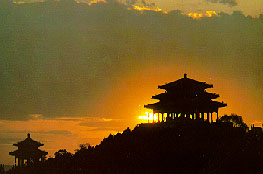|
Jingshan Park

Opposite the northern gate of the Palace Museum
is Jingshan (hill of commanding views) Park. Covering a space of
23 hectares, this park was once an imperial garden during the Ming
and Qing dynasties (1368-1911) and was only open to the public in
1928.
This artificial hill with 5 peaks was built with
the earth excavated when the moat of the Imperial Palace was dug.
5 pavilions with 5 bronze Buddhas were built on each peak in 1751
under emperor Qianlong, however 4 of the Buddhas were removed by
the troops of the Allied Expeditionary Force in 1900.
By the north upper gate is the Beautiful View Pavilion (qiwanglou) where emperors would pay their respects at an altar to Confucius. Now, it serves as a cultural exhibition venue for paintings, calligraphy and porcelain. The Pavilion of Everlasting Spring (wanchun) on top of the middle hill, used to be the highest point in the city and provides beautiful views of the center of Beijing, the northern district with the Drum and Bell Towers and the Imperial Palace. On the eastern slope is the scholar tree where the last Ming emperor Chongzhen (1628-1644), wracked with despair after rebels broke into the Forbidden City, took his own life. On the northern part of the hill is the Hall of Imperial Longevity (shouhuang), which has been transformed into the Beijing Children’s Palace where youngsters can enjoy daily extracurricular activities in dancing, singing, music and art.
|